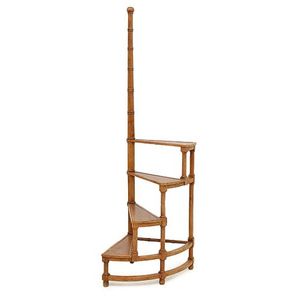Mahogany Library Steps with Leather Treads
Georgian style library steps, mahogany with tooled leather treads, 20th century, 122 cm high
You must be a subscriber, and be logged in to view price and dealer details.
Subscribe Now to view actual auction price for this item
When you subscribe, you have the option of setting the currency in which to display prices to $Au, $US, $NZ or Stg.
This item has been sold, and the description, image and price are for reference purposes only.
- Georgian - As an English stylistic period, Georgian is usually taken to cover the period from George I (1714) to the Regency of Prince George (1811-20), although the period from 1800 to 1830 is sometimes designated as the Regency period. During the Georgian period the great English cabinetmakers and designers such as Chippendale, Hepplewhite, Adam Sheraton etc., were all active.
Therefore there isn't a single 'Georgian style' as such and to say something is 'Georgian', usually means it was made between 1714 and 1830. This assumes we discount George V and George VI, both being from the 20th century.
The styles popular at the time of each reign were:
George I (1714-1727) saw out the last years of the Baroque period.
George II (1727-1760) reigned during the Rococo period.
George III (1760-1820) saw the last gasp of the Rococo, all of the early Neo-Classic 'Adam style' and most of the later neo-Classic 'Regency style'.
George IV (Prince Regent 1820-1830)encompassed the last of the 'Regency' style.
William IV's reign (1830-1837) was something of a no man's land (stylistically) and he wasn't a 'George' anyway. He covered the last glimmerings of 'Regency' and the start of the 'Victorian' style. - Mahogany - Mahogany is a dense, close grained red-coloured timber from the West Indies and Central America. It was first imported into Europe in the the early 18th century and its use continued through the 19th century. It was popular for furniture making because of its strength, the wide boards available, the distinctive grain on some boards, termed flame mahogany and the rich warm colour of the timber when it was polished.. The "flame" was produced where a limb grew out from the trunk of the tree, and this timber was usually sliced into veneers for feature panels on doors, backs and cornices.
Some terms used to describe mahogany relate to the country from which it originally came, such as "Cuban" mahogany, "Honduras" mahogany etc. However unless the wood has been tested the names assigned are more a selling feature, rather than a true indication of the timber's origin. - Tooled - Decoration of a leather surface, usually by stamping the surface with a heated punch or wheel containing foliate or geometric designs. In blind tooling the surface of the punch or wheel is in direct contact with the leather, while in gold tooling, a ribbon of gold leaf is placed between the punch or wheel and the leather, and once they have been applied, the excess gold is brushed off, leaving only the design.
- Gold Tooled - Gold tooling on leather inlays in desks and other furniture and leather book bindings refers to the decorative process of embossing the leather with a design using gold leaf. The design is first traced onto the leather and then incised into the surface using a small blade. The incisions are then gilded with thin sheets of gold leaf. The gold leaf is burnished into the leather to create a raised, metallic design. The process is repeated until the entire design is covered in gold.
- Blind Tooling / Blind Tooled - Blind tooling is a technique used in the decoration of leather goods such as book covers, belts, and wallets. It involves the use of specialized tools to impress designs and patterns onto the surface of the leather without the use of added colour.
The process involves the use of a variety of tools, including stamps, embossing tools, and finishing tools, which are used to create various textures and patterns on the leather surface. The tools are heated, and then pressed onto the leather, leaving an impression. The tools can be used to create designs that are simple or complex, with a variety of textures and patterns, including geometric shapes, florals, or scenes. The leather is then burnished to enhance the design and give it a smooth finish.
This item has been included into following indexes:
Visually similar items

Mahogany spiral library steps, with gilded metal finial, height 169 cm. Provenance: The Estate of Lady Gabriella Brenner, Bellevue Hill, NSW
Sold by
in
for
You can display prices in $Au, $US, $NZ or Stg.

A set of Regency carved and turned mahogany library steps, 19th century, 111 cm high
Sold by
in
for
You can display prices in $Au, $US, $NZ or Stg.

An adjustable timber artists easel, French, circa 1920, 206 cm high, 59 cm wide, 57 cm deep.
Sold by
in
for
You can display prices in $Au, $US, $NZ or Stg.

A set of oak four tier spiral library steps 20th century, 178 cm high
Sold by
in
for
You can display prices in $Au, $US, $NZ or Stg.
